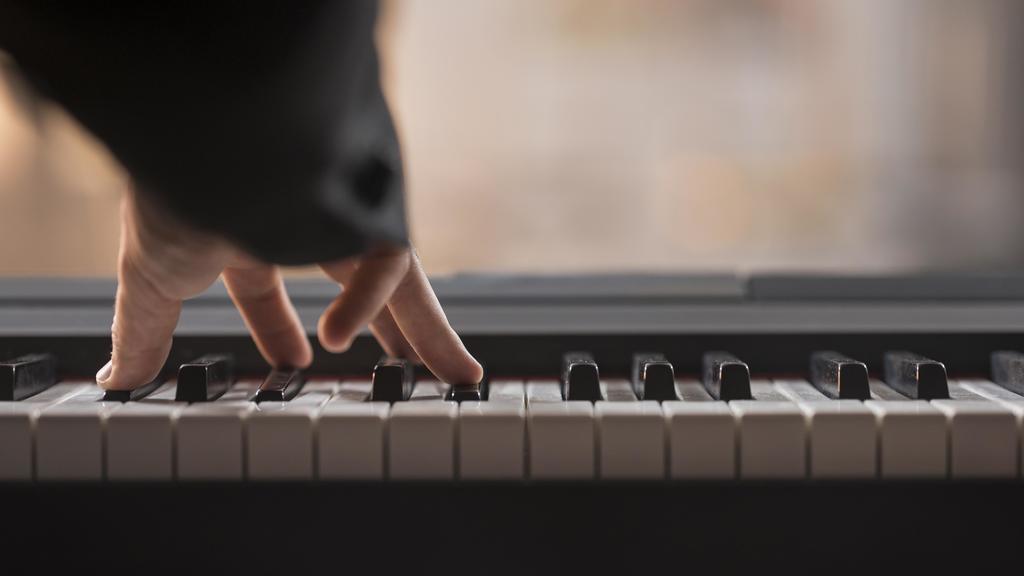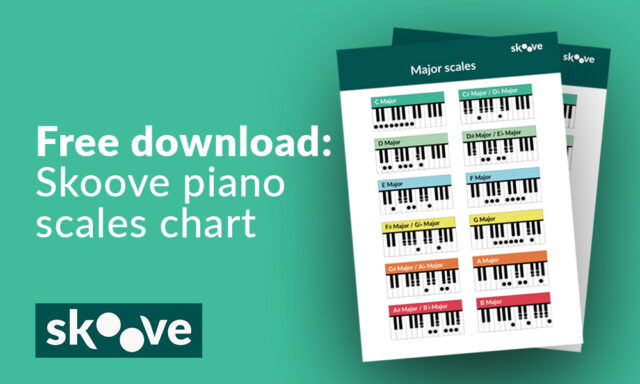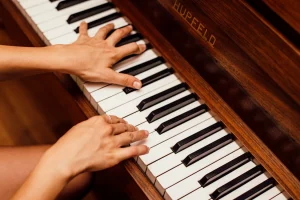Piano scales can be fun to play, especially once you get some speed up on them! Some people shy away from piano scales thinking they’re boring or difficult. But being able to race up and down on the piano with speed and agility is a great skill to have. We’ll look at the benefits of learning scales and being in the habit of practicing them daily. Perhaps one of the best reasons to learn them is to show off and wow your audience!

What are piano scales?
Scales are a progression of notes, going up, step by step, like a ladder, and coming down again. The starting note is called the root and matches the name of the scale. There are different types of scales but the ones we use most are major and minor. We’ll look at those first and later we’ll look at some different types of scales.
Why are piano scales important to learn?
There are at least three really good reasons to learn and practice piano scales:
- Dexterity: To play the piano well, your fingers need to be strong, quick and nimble. Learning and practicing piano scales every day builds strength and dexterity in your fingers.
- Finger cross-over or cross-under: Crossing fingers over and putting the thumb under is an integral part of playing the piano and learning to do this will make learning new songs quicker and easier. Classical music often has scales built into the melody line and require this technique.
- Key signature knowledge: Learning piano scales will help you learn all the major and minor keys and their key signatures. These are the basic building blocks of music theory and are really useful to know.
Basic scale structure
Here is a breakdown of piano scales for beginners.
All major scales are built out of the same pattern of whole steps and half steps. If you’re not already familiar with these intervals between notes, it’s really simple:
- Half step: The smallest distance between two adjacent keys on the piano, whether white or black. (For instance, C to C# or F to E). There is no key in between these two steps.
- Whole step: Equal to two half steps, moving two keys in either direction. (For instance, C to D or G to A). There is a note in between the two keys of a whole step.
Types of piano scales
There are quite a few different types of scales on piano. Some of the most common are major scales, minor scales (3 different types), blues scale, pentatonic (major and minor) and whole tone scale. Each type is built from a pattern of whole steps and half steps and occasionally a three half-step jump. Each scale has its own character and recognisable quality. Let’s look at each type in detail.
Major scales
We’ll begin with the C major scale. When you start to learn major piano scales, this is a good scale to start with as you don’t need to worry about sharps or flats (black keys). Learn this white-note scale first and the others will follow easily.
We think of scales as having two parts, a root and a quality. In the C major scale, the root is C, therefore we begin on the note C.
The quality of this scale is major. The following diagram shows you the major scale pattern in the key of C. Using R for root note, W for whole step and H for half steps, (these can also be called whole tones and semitones).
The pattern is: R-W-W-H-W-W-W-H. This makes a ladder starting on root C, walking up to D, E, F, G, A, B and finally arriving on C – 8 notes higher. This is called a one octave major scale.
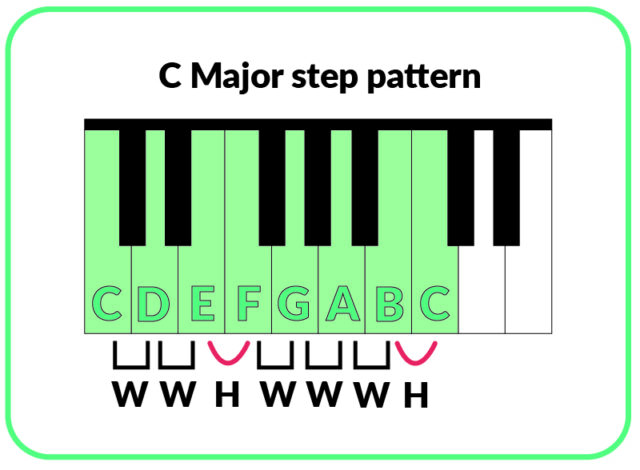
This pattern of whole steps and half steps is the same for every other major scale. So, if you learn this pattern, you can work out any major scale you like, starting on any root note, even if you don’t know the key signature.
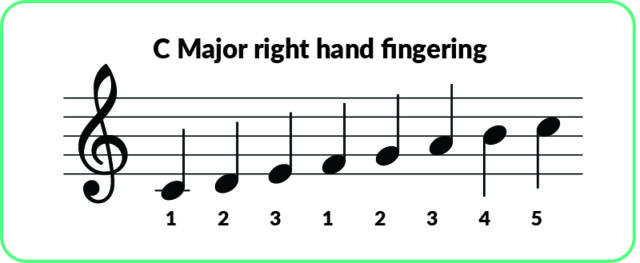
Below is the example of D major, which starts on the note D. Notice that the step pattern of whole steps and half steps is the same as C major, but this time there are two sharps (black keys). This key signature (the two sharps) ensures the pattern of whole and half steps remains the same when starting from the root note, D.
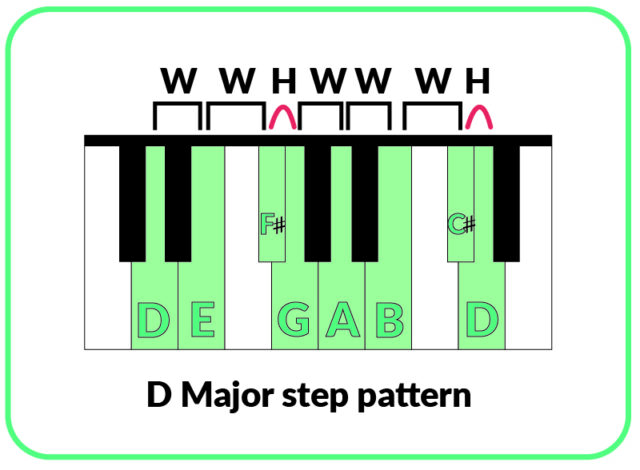
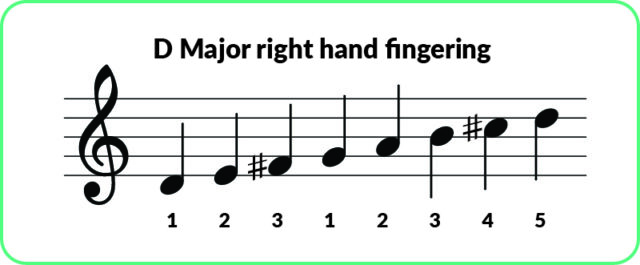
Want a guide to all major scales? Download our quick guide to major scales and get learning now!
Minor scales
While major scales have a happy sound to them, minor scales sound comparatively mysterious, sad, or exotic. They are used to express more complex emotions.
Each major key shares a key signature with a minor key. These are called “relative keys”. The minor relative is three half-steps below the root note of the major key. The chart below shows some of the most used relative keys:
| Key signature | Major Key | Relative Minor Key |
|---|---|---|
| No sharps or flats | C major | A minor |
| 1 sharp | G major | E minor |
| 2 sharps | D major | B minor |
| 1 flat | F major | D minor |
| 2 flats | B ♭ major | G minor |
Minor scales are made up of a different pattern of whole and half steps. There are three different types of minor scale and each has a distinctly characteristic sound. The three types of minor scale are:
Natural minor scale
The construction of a natural minor scale looks like this:
Tonic – Whole– Half– Whole– Whole– Half– Whole – Whole
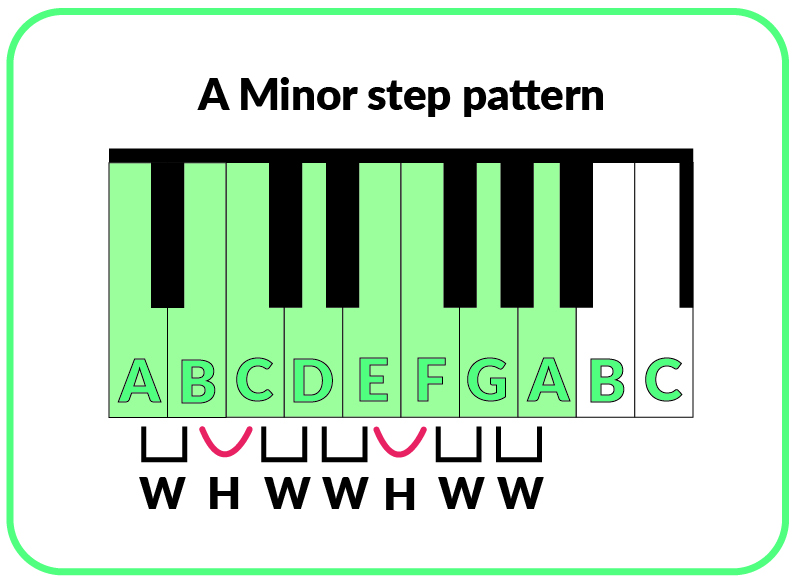
The natural minor scale is also called the Aeolian mode. The semitones are between notes 2-3 and 5-6.
Harmonic minor scale
The harmonic minor scale is notable for its raised 7th note which does not appear in the key signature. This raised 7th means there is an interval of 3 half steps between the 6th and 7th note. The harmonic minor scale is one of the most commonly used minor scales in western music.
The construction looks like this:
R–W–H–W–W–H–3 Half Steps–H
In the key of A minor, the scale is spelled A – B – C – D – E – F – G♯ – A. Notice the only difference between the harmonic minor scale and the natural minor scale is the raised 7th scale degree which isn’t raised in the natural minor.
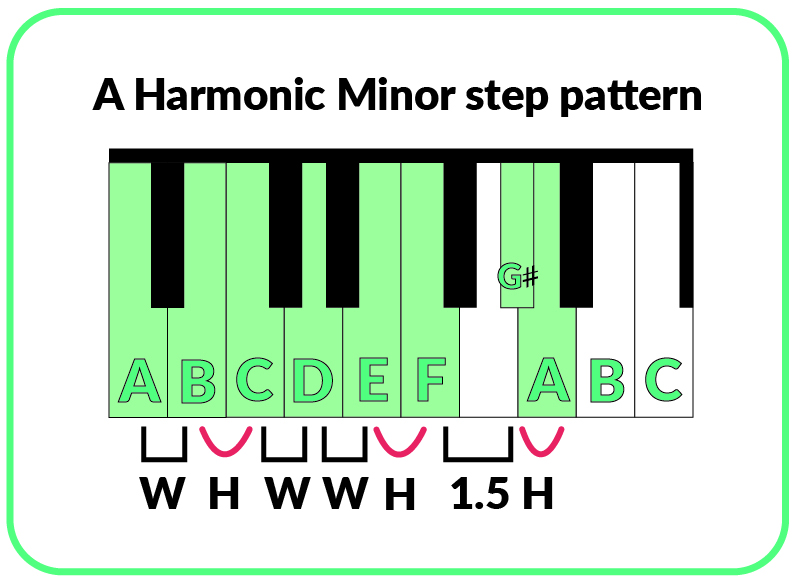
Melodic minor scale
The melodic minor scale is a variation of the natural minor scale. Ascending, it raises the 6th and 7th degrees by a half step, making it sound like a major scale after the flattened third note. Descending, it reverts to the natural minor form, abiding by the key signature, exactly like the natural minor scale.
It is constructed like this:
- Ascending: R–W–H–W–W–W–W–H
- Descending: R–W–W–H–W–W–H–W
The C melodic minor ascending scale is spelled C – D – E♭ – F –G – A – B – C. Descending, it matches the C major scale.
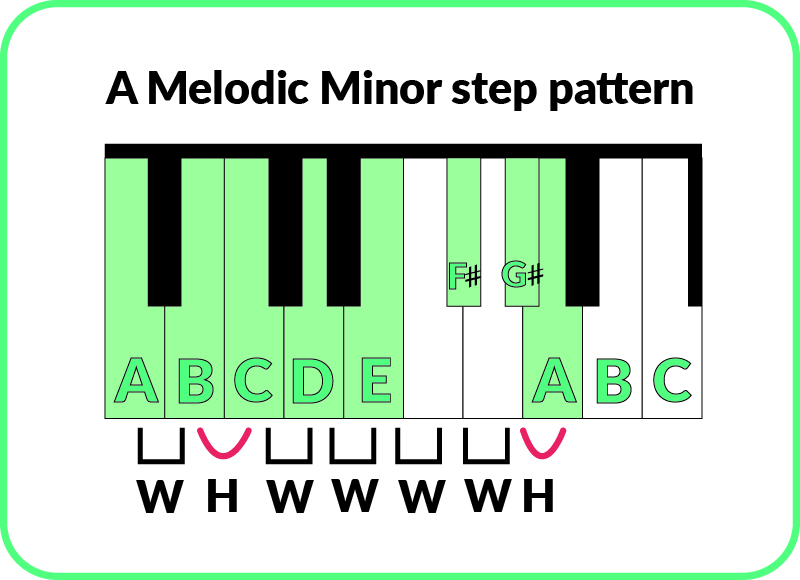
Chromatic scales
A chromatic scale does not conform to any specific key. But the word chromatic relates to color, meaning that you go through every hue – like a rainbow. In the same way, this scale goes through every available tone.
A chromatic scale can start on any note and includes every note – black or white – as it goes up or down. The whole step/half step pattern is simply R-H-H-H-H-H-H-H and continues like this for as long as required.
There is a specific fingering pattern to use for any chromatic scale that shows up in a piece of music. Here is the fingering for each hand.

Pentatonic scales
Pentatonic scales only consist of 5 notes, so they are easy to find and play as they fall under the fingers in a very organic way. Many blues and jazz songs use this scale and it’s also a good scale to use for improvisation.
Major pentatonic scale
The major pentatonic is structured like this:
R–W–W–3 Half-Steps–W–
The C major pentatonic scale is spelled C – D – E – G – A. The fingering for the pentatonic scale is simply 1 2 3 4 5. Try it out and you’ll see it’s easy to play. Try it starting on various root notes.
Minor pentatonic scale
The minor pentatonic has much more of a blues feel. The minor third and the raised fifth make it sound this way. The minor pentatonic scale pattern is:
R–3 Half-Steps–W–W–3 Half-Steps–W
The C minor pentatonic scale is spelled C – E♭ – F – G – B♭. Try it out and then try different root notes. You might find yourself making up your own song.
Whole tone scale
The whole tone scale sounds ethereal and romantic. Claude Debussy used this scale frequently in his music. Listen to “La Fille Aux Cheveux De Lin“ to get the sense of wonder that this scale conjures. You can try the lesson here.
As the name implies, the whole tone scale is built in a series of whole steps like this:
R-W–W–W–W-W-W
It is a six note scale. The whole tone scale beginning on C is spelled
C – D – E – F♯ – G♯ – A♯ – C.
Piano scales generator
This piano scales generator from Pianoworld is a handy tool to learn scales. It is interactive and easy to use. If you are reading this from a mobile device, rotate it to display the tool in full width.
1. Click on “Scale”
2. Choose the “Root” of the scale
3. Choose the “Type” (major, minor, etc.)
4. Click “Display”
* You can do the same with scales.
** You can invert chords and scales
How to practice piano scales
Here we’ll talk about how to practice scales on piano. Knowing scales will give you a good understanding of key signatures and help with reading piano sheet music. Once you have learned them, make practicing them part of your daily routine. They make a great warm-up to a practice session.
Hand position and fingering for piano scales
The most important thing for beginners when learning piano scales is to use a good hand position as well as the correct finger on each note.
The correct piano hand position is hovering above the keys with the fingers curved slightly downwards towards the keys. There should be a space between your palm and the piano keys. Keep your hand very relaxed.
Fingering for other scales
Several scales have the same finger patterns as C major, while some are different (for instance the scales that start on a black note). Be sure you learn the correct finger numbers for each scale. This enables fast and accurate playing.
Playing hands together
Playing piano scales hands together can feel tricky at first. Remember to go very slowly, think one step ahead and keep your hands relaxed.
When you play a scale hands together, each hand goes over (with finger 3) or under (with the thumb) at different times, so it takes slow careful practice in the beginning. Once you’ve practiced half a dozen or so times it will start to feel easier.
Other major scales that use the exact same fingers numbers and pattern as C major are: G, D, A and E, so these are good ones to go on to practice after you’ve mastered C major. Use the whole and half-step chart above to work out which black keys each of these scales needs.
Different fingering for some piano scales
A few scales are the same as C major in one hand but not the other. These are F major: the left hand is the same as for C major, but the right hand thumb goes under after finger 4 plays the Bb. B major is the same as C major in the right hand, but the left hand starts on finger 4. These vary only because they encounter black notes that make it difficult to follow the same fingering as C major.
Practicing scales in contrary motion
Contrary motion means playing in opposite directions. In contrary motion scales, one hand ascends while the other descends, making them both fun and challenging to play. Practicing these scales helps build advanced skill and techniques.
How to memorize piano scales
The best way to memorize piano scales is to play them every day three or four times. After enough repetition, you’ll find that your fingers actually memorize what to do without you thinking about it very much. To reinforce this, look away from your fingers as much as you can.
Building memorization can be quicker if you practice the scales in order of key signatures. For example, start with C major, then G major (which has one sharp), then D major (which has two sharps) and so on. Then go through the “flat” keys. F major has one flat, Bb major has two flats, and so on.
Have fun learning the minors as well as the majors. If you keep a copy of the circle of fifths (a type of piano scales chart) on your piano music stand – or on your wall, you will quickly learn all piano scales and key signatures. Not only will this give you great finger dexterity and skill, it will also give you a huge advantage when it comes to learning new songs!
Learn your scales!
Exploring new scales and patterns can lead to exciting musical discoveries. You might try a scale that evokes sadness, sunlight, outer space, or something wild like the chromatic scale! You can also experiment by combining these scales with b a basic piano chord.
Composers and pianists of all levels practice scales because they unlock new keys and ways to express yourself. To deepen your musical expression, consider online piano lessons using the piano learning app Skoove’s free trial!
Author of this blog post
Vicki Young

Vicki Young is a pianist and singer with a degree in Music from the University of Sheffield. She lives in London, UK with her husband and son. Vicki is a communications and marketing freelancer who has worked with a range of organizations across the music and charity sectors.
Published by Lydia Ogn from the Skoove team







